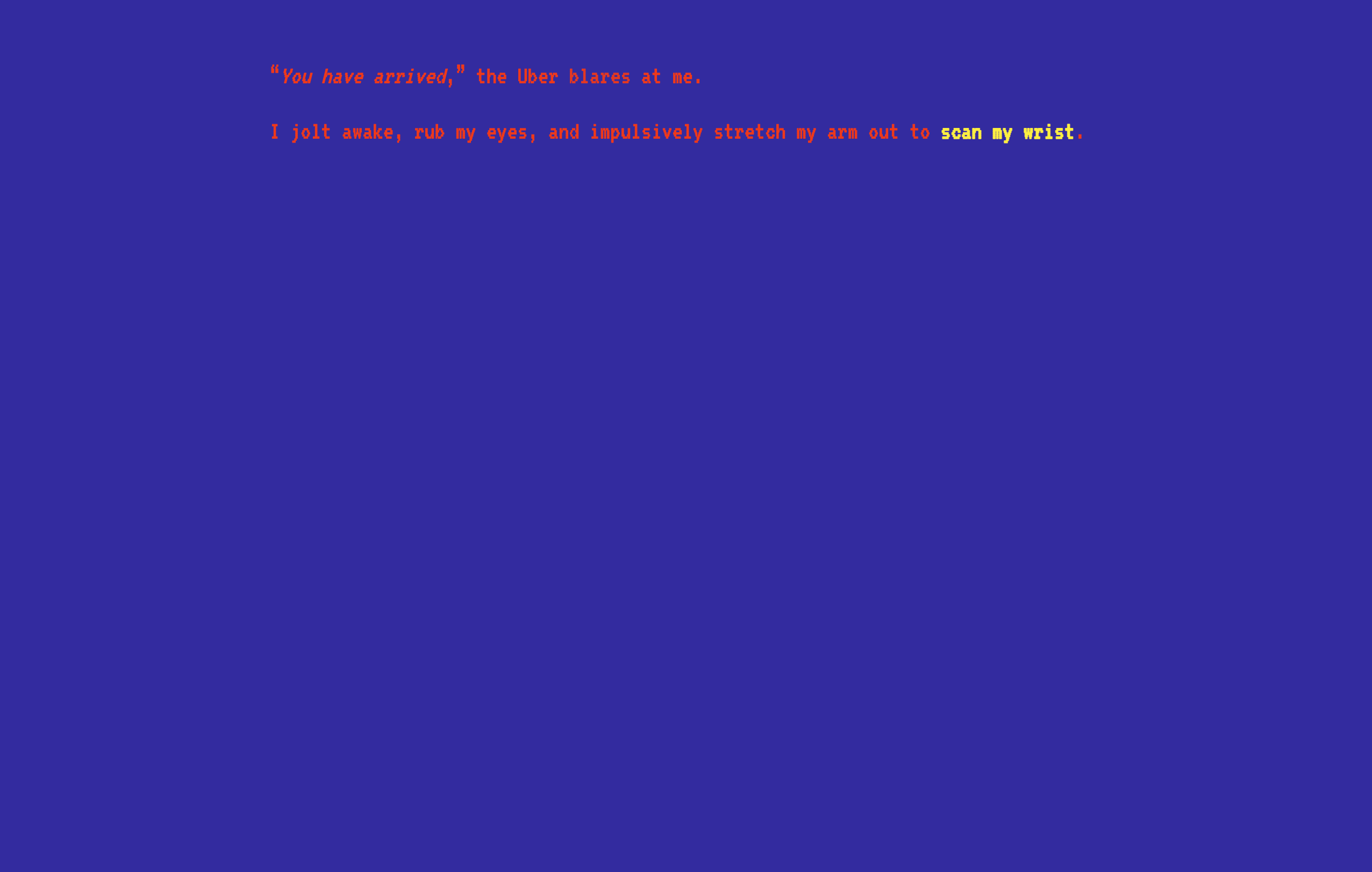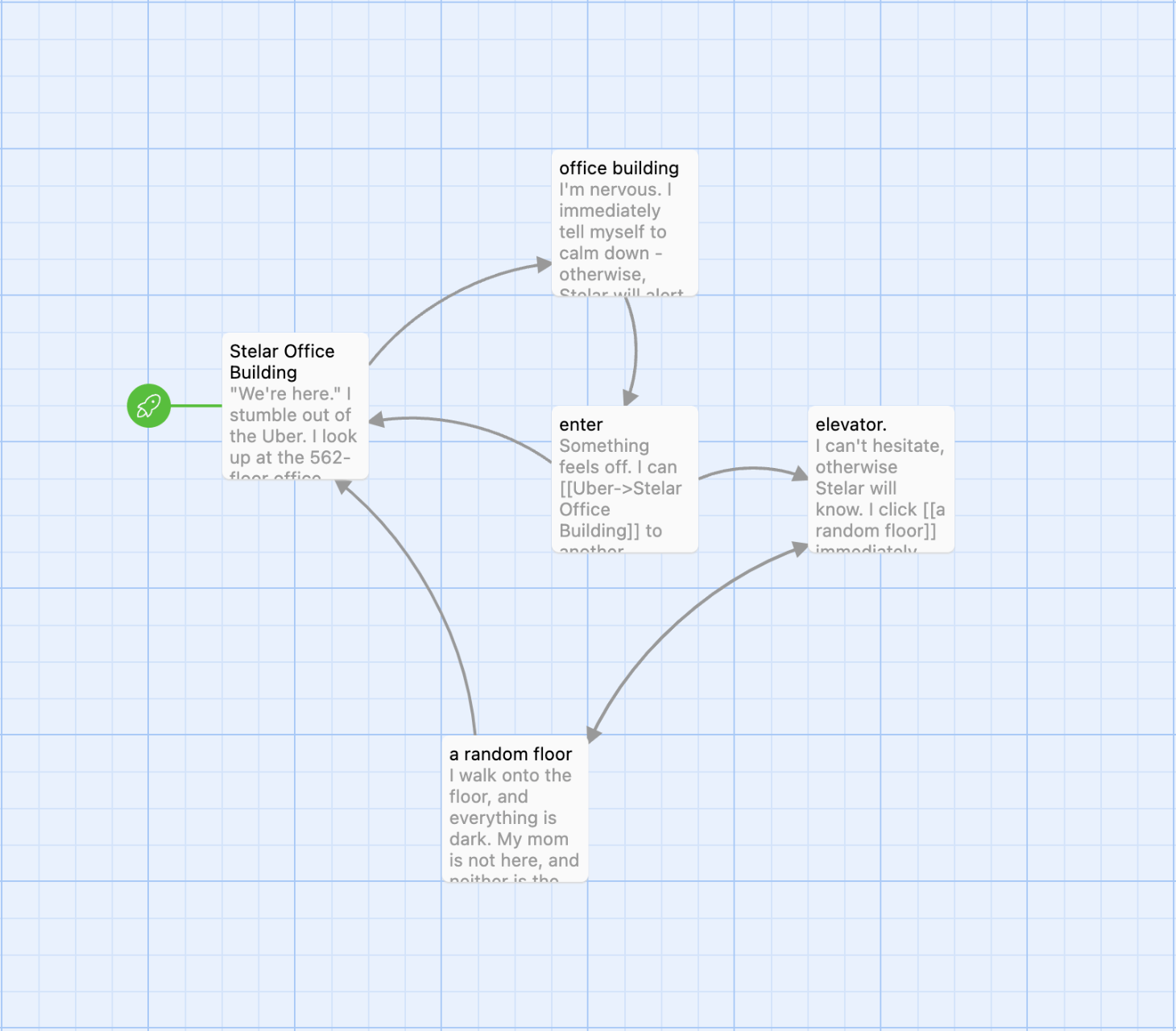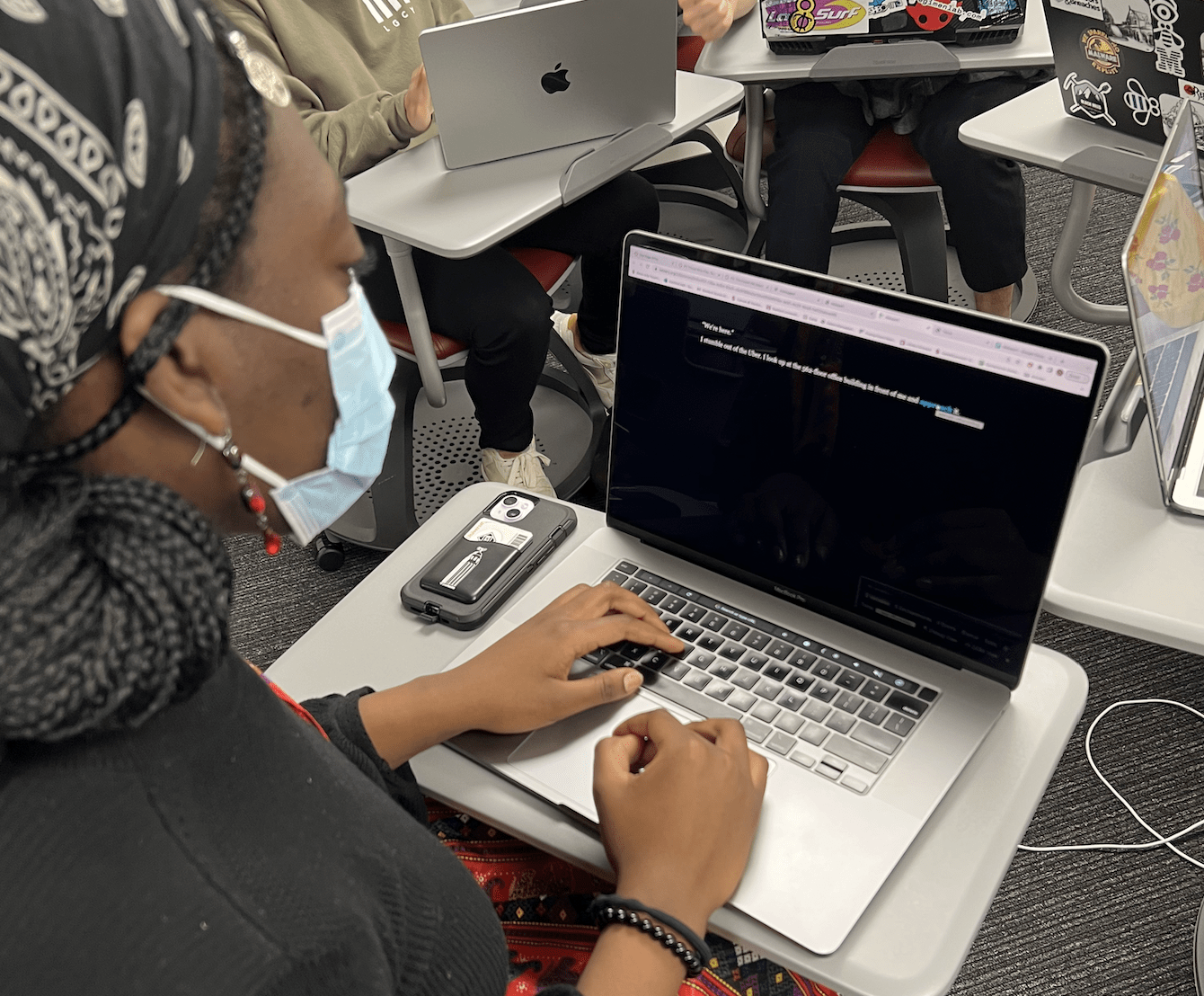
https://cggao.itch.io/malapert
Premise:
Internet giants, like Google and Meta, have grown to the point where they now have direct influence over three-quarters of all internet traffic. They can monitor what (almost) every user does online – what they watch, buy, like, dislike, and more. In a world where personal information is big business, and ownership is in the hands of just a few people, the prospect of a techno-dystopia, where “big brother” knows everything about everyone, doesn’t seem so far-fetched.
In this dystopia, one company – Stelar, has taken over the world. It doesn’t matter what country you’re from, or where on Earth you’re currently located, Stelar rules the world and Stelar knows all. The only thing private are one’s own thoughts. Stelar, however, is about to release a device, Link, that will be able to track and analyze everyone’s thoughts now, too. A Stelar executive’s daughter, Cat, doesn’t want this device to be released; (1) she values privacy, and (2) her mother, the executive, never paid any attention to her because of Stelar, and she wants her mother to fail.
Cat has just arrived at her mother’s office building – the first step in her attempt to destroy Link. Cat navigates through the office building and makes certain decisions that affect how she goes about destroying Link. In the end, Cat finds out her mother, the Stelar executive, wanted to destroy Link this whole time, too. Players will walk away with a stronger value and appreciation of data protection / privacy.
Morals:
- Even though someone, technology, or a whole company, may know everything you do, they don’t know how you feel.
- A world without privacy suppresses authenticity and anyone from acting in a way that truly represents themselves.
Initial Concept Mapping:
My initial concept map explored the various decisions and directions / conflicts Cat could face in her attempt to destroy Stelar: facing guards, trying a different office building, etc.

Playtesting / Iteration:
[1] Ecy
For this first playtest with Ecy, I had written Malapert’s opening scene: Cat arrives at the Stelar office building, enters, and decides which floor to go to. My goal here was to see if playtesters could understand what Stelar was (a “big brother” company that tracks everything you do) without directly saying so in the text. I was also curious about the reasoning behind how playtesters chose which floor to go to (or action to take).

Playtesters could, indeed, understand (via certain word choices and scenes) that Stelar was a “bad” company that was aiming to collect data from you. The choices I had laid out, though, were too broad and not fleshed out. It was almost too obvious that Stelar was a “bad” company.
Some other things to consider were – if this were a future dystopia, what technologies would still exist? Would Uber operate the same way? I played around with making Uber self-driving in the next iteration, then, to make the scene / setting more cohesive.

[2] Alyssa
This playtest was with Alyssa; the entire plot of Malapert had been written into Twine, with the choices the main character Cat could make all fleshed out. I made the setting more future-cohesive (ex. I added a device embedded in everyone’s wrists – the device Stelar uses to track everything everyone does; I used this to “scan” out of a self-driving Uber, vs just getting out of an Uber, for example).

- After the first half of the game, Alyssa was able to understand “there’s this Stelar that has all of our data. It’s a surveillance state, and Link is about to be released, which will capture everyone’s thoughts, too.”
- There were certain wording choices that were unclear and / or repetitive: “Mom’s floor… Mom’s office…,” etc.
- There was a disconnect when Cat chooses to snoop on her mom’s computer, and sees SCHOOL PROJECT for the first time (I forgot to add context as to why SCHOOL PROJECT was a choice in this path).
- The ending seemed too rushed / convenient; “why was the mom’s message on a random Hololens? Why didn’t the mom just tell her all of this before? It wasn’t clear how difficult, or why, the mom had to get this message to Cat in this way.”
- The ending felt a bit abrupt, too.
Alyssa understands the need for privacy; after playing the game, Alyssa felt grateful for currently living in a place that (at least tries?) to value user privacy. She understood why society at large needs to value privacy, but mentioned that the game didn’t necessarily persuade her to act at an individual level.

[3] Clarissa
I modified certain wording and scenes to make the ending less “convenient” (ex. expressed how difficult it was for the mom to get the ending message to Cat, vs the message just being there). I clarified other wording choices and other disconnects. I added another ending scene to make the ending less abrupt and more “to be continued.” This time, with Clarissa as my playtester, I also added visual effects to make the experience more engaging; I changed the background, font, colors, and added delayed text and animations to each page. I added delayed text to each page to slow the player down (oftentimes, I noticed if I displayed larger chunks of text, the player would skim over the text and focus / click on options before fully processing what was happening). The delayed text, though, can be distracting at first; it takes time to get used to it. Players suggested a click-at-your-own-rate feature.

- Clarissa wondered if going through one option vs another leads her to missing certain pieces of information.
- Clarissa was able to understand Stelar was an “evil” company quickly.
Clarissa mentioned, before playing, that she doesn’t think about data / privacy – it doesn’t affect her everyday life. After playing, Clarissa could see why it’s important to stop one company from collecting everything (but was still grappling with the fact that you might only really be worried today if you planned to do something bad, like rebel).

Feedback:
See above for detailed feedback from each playtester and how it was incorporated into the next iteration of the game. Key points include:
- Making the setting more future-cohesive (ex. I added a device embedded in everyone’s wrists – the device Stelar uses to track everything everyone does; I used this to “scan” out of a self-driving Uber, vs just getting out of an Uber, for example).
- Ensuring there were no disconnects between different paths (there was a disconnect when Cat chooses to snoop on her mom’s computer, and sees SCHOOL PROJECT for the first time – I forgot to add context as to why SCHOOL PROJECT was a choice in this path).
- Updating the ending to not be too rushed / convenient or abrupt; “why was the mom’s message on a random Hololens? Why didn’t the mom just tell her all of this before? It wasn’t clear how difficult or why the mom had to get this message to Cat in this way.”
Reflection:
For this project, I created Malapert – an interactive fiction that raises awareness about the dangers of corporate data collection / a potential world without privacy. I designed the game so that the player discovers what dystopia they are in as they play / progress through the game, vs knowing beforehand (doing so, I find, increases engagement; players discover one thing about the world and want to know more). Once the player realizes the type of world they are in, the player then has opportunities to (1) make certain decisions that affect how they try to destroy the company that enforces the surveillance state and (2) reveal certain information about their relationship with their mom, too. At the end of the game, players will walk away with a stronger value and appreciation of data protection / privacy.
I used Twine’s platform to implement visual design choices (i.e. color, font, etc.) to make the game more engaging and set the tone / make the game more futuristic. As mentioned above, a big design choice was adding delayed text to each page to slow the player down (oftentimes, I noticed if I displayed larger chunks of text, the player would skim over the text and focus and click on options before fully processing what was happening). Using Twine allowed the story to be truly interactive because of the many ways the player could discover more information about Stelar and / or act – for example, deciding to leave a digital footprint or not.
I learned a lot while creating Malapert! I learned how to use Twine, how to write more effectively / engagingly (how to slowly reveal what type of world / dystopia a player may be in, for example), what a meaningful choice is, and most importantly, that scoping is a huge factor to consider. At what level of detail do I give players a choice, for example? How often should I give users a choice, and what outcome should this choice lead to? Oftentimes, it’s easy to brainstorm and have a strong idea of how you’d convey a certain message or have certain events take place; but, in reality, it’s really difficult and time intensive to implement. It’s easy to rabbithole on one decision that may or may not affect your overall plot. It’s also easy to overlook the details of how each choice will affect other choices. You really have to think critically about where the story might intersect again (vs going in a completely new direction). Re: data privacy, I learned that people generally know that data collection is bad, but most people don’t do anything about it because it doesn’t affect their everyday lives. Placing players in a world with no privacy helped communicate what data collection to its extreme can lead to, and why they should think about it more.
Next time, I’d like to scope the story differently. I’d love for Cat to explore the Center, for example, and play around with more endings – is there a different path where Cat gets locked in the Center, and her mom (surprisingly) comes to rescue her? Or perhaps certain actions lead to an ending where her mom doesn’t end up revealing to Cat that she wanted Stelar destroyed the whole time? With more time, I’d also play around with more visual and audio effects. I’d also like to explore the concept of “items” – i.e. have players collect a certain item before being able to move on in the story / game. I’d also love to explore more effective ways to get players to think about how data collection affects them on an individual level (vs societal level). What scenario can lead to someone acting on this?



It was really cool to see the final version of this game, since I playtested it a couple weeks ago! The game really communicates the importance of data privacy, and how a world without privacy is a scary place where people are no longer free to say and do what they want. I thought the time delay on each line was interesting. It was frustrating half the time – because I really wanted to move faster and know what was going to happen next! But overall I think it was a good choice: I read every single line and personally felt like I was living within a system that forced me to behave/slow down – in the same way that the main character can’t let their heartbeat get too fast.
I also really liked the aesthetic choices – the background color and animated words all made me feel like I was in some futuristic system with a mind of its own. This was a really effective use of Twine, and effectively created a setting without the need for any images.
If this were to turn into P4, I would be interested in some big climax at the end. I like how the ending has expanded since the last time I played it – and now I’d love to see even more!! What would it be like to take down Stelar? Why is my mom able to run away now, and why didn’t she do it before? Do my choices matter, or was I bound to be swept away by my mom?
This game imparts on the player a sense of skepticism about the future of Big Data and invasive surveillance tech by weaving the protagonist’s (entirely justified) surveillance paranoia into every thought, choice, and consequence. I found this approach to be incredibly effective, as it required me to place myself in the protagonist’s shoes and thoroughly consider the possible risks of every choice. I found myself frequently surprised when my choices led to consequences which were unintended on my part yet made complete sense within the context of the story, such as when I entered the coffee shop with the intent of exploring only to discover the caffeine could function as an alibi for my anxious biosignals. Whenever this occurred, it expanded my thinking about the less obvious ways this level of surveillance would fundamentally change the way people think and live.
I believe this game utilized the IF format very effectively. I tried my best to explore every route and believe I clicked on almost every choice at least once, and I was surprised to find that the story was relatively linear and that most choices ultimately led to the same outcome with only minor differences. I was surprised because the way the choices were framed (and the way their outcomes were written) made them feel meaningful, and I didn’t suspect the linearity of the story until playing through multiple times. I do not think the lack of significant branching detracted from the story at all, because the impact of the choices instead came from their function in forcing the player to consider risks and rewards, thus immersing them in the dystopia.
I adored all of the formatting choices as well! The use of colored and animated text was engaging, and the slow fade-in of paragraphs forced me to experience the world at the same pace as the protagonist, which was especially immersive every time they needed to count in order to calm down. My only suggestion would be to include some explicit ending card, because the first time I reached the ending, I did not realize the game had ended; I thought the page was just glitching and failing to load additional text, and it took another playthrough to realize the siren fade-out was actually the end of the game.